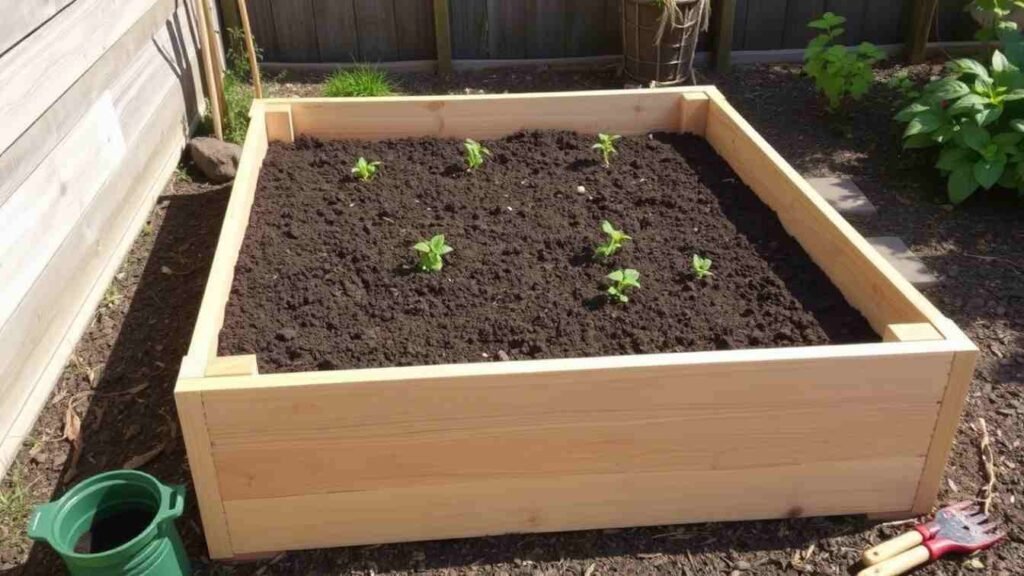Square foot gardening is a revolutionary approach to growing food that maximizes productivity in minimal space. Whether you’re working with a tiny backyard, a balcony, or even an indoor area, this method allows you to grow fresh produce efficiently and sustainably. In this comprehensive guide, we’ll walk you through everything you need to know about square foot gardening—from setting up your grid to choosing the right crops and maintaining your garden year-round. By the end, you’ll have all the tools and knowledge to create a thriving, high-yield garden no matter how limited your space!
1. What Is Square Foot Gardening?
Square foot gardening is a simple, efficient way to grow vegetables, herbs, and flowers in small spaces. Developed by Mel Bartholomew in the 1970s, this method divides a garden bed into a grid of 1-foot squares, each dedicated to a specific type of plant.
Key Benefits:
- Space Efficiency: Maximizes yield in compact areas.
- Easy Maintenance: Reduces weeds, watering needs, and physical strain.
- Cost-Effective: Uses less soil and fewer seeds than traditional gardens.
- Beginner-Friendly: Simplifies planning and planting for novice gardeners.
2. How to Set Up Your Square Foot Garden
Getting started is easier than you might think. Follow these steps to create your own square foot garden:
Step 1: Choose the Right Location
- Sunlight: Select a spot with at least 6–8 hours of direct sunlight daily.
- Accessibility: Ensure easy access for watering, harvesting, and maintenance.
- Drainage: Avoid low-lying areas where water pools after rain.
Step 2: Build or Purchase a Raised Bed

- Use untreated wood, bricks, or recycled materials to construct a rectangular frame (typically 4×4 feet).
- Fill the bed with a nutrient-rich soil mix made of equal parts compost, peat moss, and vermiculite (Mel’s Mix).
Step 3: Create the Grid
- Divide the bed into 1-foot squares using string, wood slats, or durable tape.
- Label each square to keep track of what you’ve planted.
Pro Tip:
For urban gardeners, consider stacking multiple levels vertically to maximize space.
3. Planning Your Crops
One of the most exciting aspects of square foot gardening is deciding which plants to grow. Here’s how to plan effectively:
Crop Spacing Guidelines
- Small Plants (e.g., radishes, carrots): 16 plants per square foot.
- Medium Plants (e.g., lettuce, spinach): 9 plants per square foot.
- Large Plants (e.g., peppers, tomatoes): 1 plant per square foot.
- Extra-Large Plants (e.g., broccoli, cabbage): 1 plant every 2–4 square feet.
Companion Planting Tips
- Pair compatible plants to deter pests and improve growth (e.g., marigolds with tomatoes).
- Rotate crops seasonally to prevent nutrient depletion and reduce disease risk.
Seasonal Planning
- Spring: Cool-season crops like lettuce, peas, and spinach.
- Summer: Warm-season favorites like tomatoes, cucumbers, and zucchini.
- Fall: Hardy greens like kale, Swiss chard, and Brussels sprouts.
Follow our DIY raised garden bed step-by-step tutorial to create a beautiful and productive growing space.
4. Maintaining Your Square Foot Garden
Once your garden is set up, proper care ensures healthy plants and bountiful harvests:
Watering
- Water deeply but infrequently to encourage strong root development.
- Use a soaker hose or drip irrigation system to minimize waste and prevent leaf diseases.
Fertilizing
- Add compost or organic fertilizer every 4–6 weeks to replenish nutrients.
- Mulch around plants to retain moisture and suppress weeds.
Pest Control
- Inspect plants regularly for signs of pests or diseases.
- Use natural remedies like neem oil or introduce beneficial insects like ladybugs.
5. Troubleshooting Common Issues
Even the best-laid plans can encounter challenges. Here’s how to address them:
Overcrowding
- Thin seedlings early to give plants room to grow.
- Stick to recommended spacing guidelines.
Poor Soil Quality
- Test soil pH and amend as needed (most vegetables prefer slightly acidic to neutral soil).
- Refresh the soil annually with fresh compost.
Low Yields
- Ensure adequate sunlight and consistent watering.
- Experiment with different varieties suited to your climate.
6. Advanced Techniques
Take your square foot garden to the next level with these innovative strategies:
Vertical Gardening
- Train vining plants like beans, cucumbers, and squash to climb trellises or stakes.
- Save ground-level space for compact crops.
Container Adaptations
- Repurpose buckets, bins, or fabric grow bags for portable square foot gardens.
- Ideal for renters or those with limited outdoor space.
Year-Round Gardening
- Extend the growing season with cold frames, row covers, or indoor grow lights.
- Experiment with winter-hardy crops like garlic, onions, and parsley.
7. Ecological Benefits of Square Foot Gardening
Beyond convenience, this method offers significant environmental advantages:
- Reduced Waste: Minimizes water usage and eliminates the need for chemical fertilizers.
- Pollinator Support: Attracts bees and butterflies when flowering plants are included.
- Sustainable Practices: Encourages organic gardening and reduces reliance on store-bought produce.
Conclusion
Square foot gardening is a game-changer for anyone looking to grow fresh, healthy food in limited space. With its straightforward setup, efficient design, and versatility, it’s perfect for urban dwellers, families, and seasoned gardeners alike. Armed with the tips and insights from this guide, you’re ready to transform any corner of your home into a productive, eco-friendly oasis. Happy gardening!

